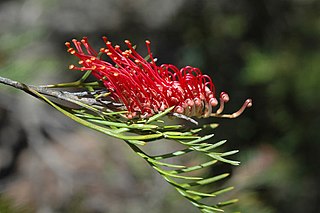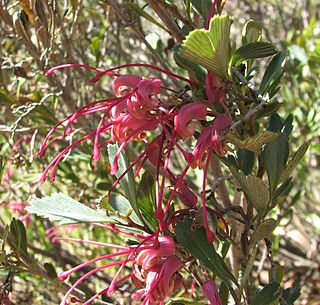
Grevillea petrophiloides, commonly known as pink pokers, rock grevillea or poker grevillea, is a species of flowering plant in the family Proteaceae and is endemic to the south-west of Western Australia. It is an erect shrub with divided leaves, the lobes mostly linear, and cylindrical clusters of usually pink to reddish pink and bluish-grey flowers.

Grevillea preissii and is endemic to the southwest of Western Australia. It is a mounded to spreading or dense, erect shrub, the leaves divided with 5 to 7 linear to more or less cylindrical lobes, and groups of reddish flowers arranged along one side of the flowering rachis.

Grevillea bipinnatifida, commonly known as fuchsia grevillea, is a species of flowering plant in the family Proteaceae and is endemic to the south-west of Western Australia. It is a spreading shrub, usually with bipinnatifid leaves and loose clusters of dull pink to crimson flowers.

Grevillea crithmifolia is a species of flowering plant in the family Proteaceae and is endemic to the south-west of Western Australia. It is a dense shrub with linear leaves, divided leaves with narrowly oblong lobes, or both, and clusters of pale pink to creamy-white flowers.

Grevillea manglesii is a species of flowering plant in the family Proteaceae and is endemic to an area around Perth in Western Australia. It is a spreading shrub with divided leaves, with triangular or linear lobes, and clusters of cream-coloured or white flowers.

Grevillea concinna, commonly known as red combs or elegant grevillea, is a species of flowering plant in the family Proteaceae and is endemic to the south-west of Western Australia. It is a spreading to erect shrub with mostly linear to narrow wedge-shaped leaves sometimes with a sharp point on the tip. Flower colour varies with subspecies.

Grevillea hookeriana, commonly known as red toothbrushes or Hooker's grevillea, is a species of flowering plant in the family Proteaceae and is endemic to the south-west of Western Australia. It is a spreading to erect shrub, usually with linear leaves or deeply divided leaves with linear lobes, and toothbrush-shaped groups of red, black or yellowish green flowers, the style maroon to black.

Grevillea agrifolia, the blue grevillea, is a species of flowering plant in the family Proteaceae and is native to the north of Western Australia and parts of the Northern Territory. It is a shrub or tree with narrowly oblong leaves with the narrower end towards the base, and creamy-yellow flowers.

Grevillea pectinata, commonly known as comb-leaf grevillea, is a species of flowering plant in the family Proteaceae and is endemic to the south of Western Australia. It is a spreading shrub with divided, comb-like leaves and mauve-pink to red and cream-coloured to yellow flowers with a red to deep pink style.

Grevillea diversifolia, the variable-leaved grevillea, is a species of flowering plant in the family Proteaceae and is endemic to the south-west of Western Australia. It is an erect to prostrate shrub with simple or divided leaves and groups white to cream-coloured flowers with a dull red style.

Grevillea dryandroides, commonly known as phalanx grevillea, is a species of flowering plant in the family Proteaceae and is endemic to the south-west of Western Australia. A diffuse, clumping shrub, it often forms suckers and has divided leaves with up to 35 pairs of leaflets, and groups of red to pinkish flowers on an unusually long, trailing peduncle.

Grevillea nana, commonly known as dwarf grevillea, is a species of flowering plant in the family Proteaceae and is endemic to the south-west of Western Australia. It is a prostrate to low, mounded, dense shrub with divided leaves with sharply-pointed, linear lobes, and clusters of pink, ornage, yellow or red flowers.
Grevillea nematophylla, commonly known as water bush or silver-leaved water bush, is a species of flowering plant in the family Proteaceae and is endemic to Australia. It is shrub or small tree with simple or pinnatisect leaves, the leaves or lobes linear, and branched, cylindrical clusters of cream-coloured flowers.

Grevillea baxteri, commonly known as the Cape Arid grevillea, is a flowering plant of the family Proteaceae and is endemic to the south-west of Western Australia. It is an erect to spreading shrub with pinnatipartite leaves and greenish to fawn or creamy-orange flowers.
Grevillea calcicola is a species of flowering plant in the family Proteaceae and is endemic to the north-west of Western Australia. It is a much-branched shrub with pinnatisect leaves with linear lobes, and off-white to cream-coloured flowers.

Grevillea calliantha, commonly known as Foote's grevillea, Cataby grevillea or black magic grevillea, is a species of flowering plant in the family Proteaceae and is endemic to a restricted part of the south-west of Western Australia. It is a spreading, compact shrub with pinnatipartite leaves with linear lobes, and pale yellow to apricot-coloured flowers with a maroon-black to reddish style.

Grevillea obliquistigma is a species of flowering plant in the family Proteaceae and is endemic to the south-west of Western Australia. It is a spreading shrub with linear leaves, and conical to cylindrical clusters of creamy-white to yellowish cream-coloured flowers, sometimes tinged with pink.

Grevillea patentiloba is a species of flowering plant in the family Proteaceae and is endemic to the south-west of Western Australia. It is a prostrate to erect, spreading to straggling shrub with divided leaves, and down-turned clusters of red to deep pink and cream-coloured to bright yellow flowers with a red to deep pink style.

Grevillea prostrata, commonly known as the Pallarup grevillea, is a species of flowering plant in the family Proteaceae and is endemic to a small area in the southwest of Western Australia. It is a prostrate shrub with more or less pinnatisect leaves and pink and white flowers with a white style.

Grevillea neorigida is a species of flowering plant in the family Proteaceae and is endemic to Western Australia. It is compact, spreading shrub with deeply-divided leaves, the end lobes linear and somewhat sharply-pointed, and clusters of creamy-brown to off-white flowers with a scarlet or orange-red style.



















